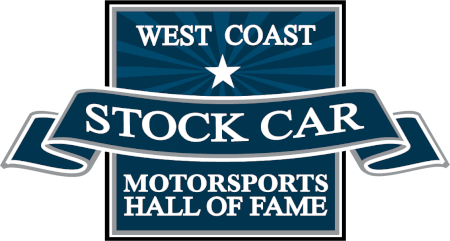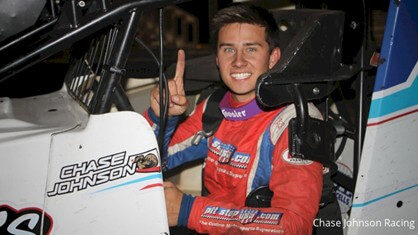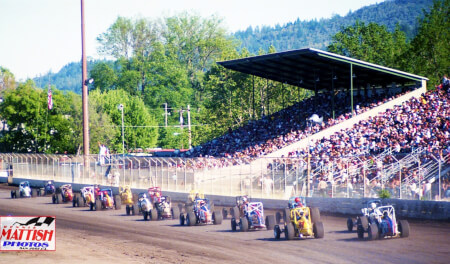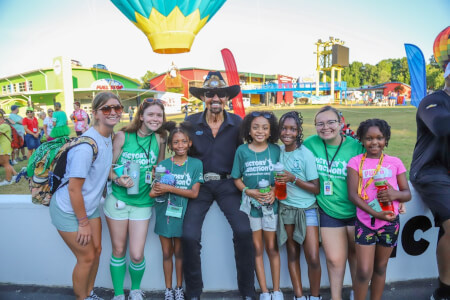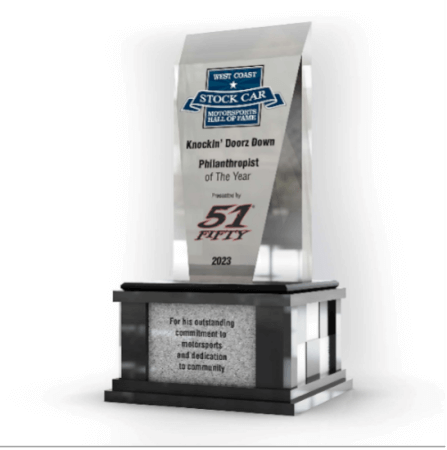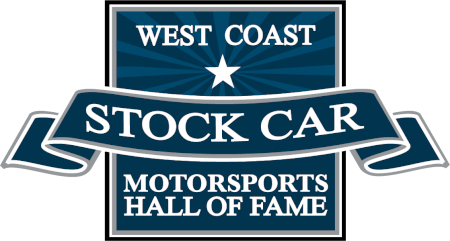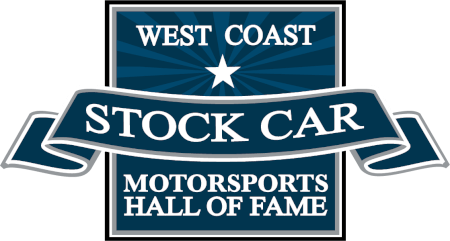February 24th 2025
West Coast Stock Car/Motorsports Hall of Fame Salutes 2025 Pioneers of Speed
The West Coast Stock Car/Motorsports Hall of Fame will memorialize its second class of its Pioneers of Speed during the 2025 Induction Gala, presented by World Wide Technology Raceway at Gateway, on Thursday, March 13, at the South Point Hotel and Casino in Las Vegas.
The Pioneers of Speed category recognizes those whose accomplishments created the foundation of the racing we know today. This year’s inductees recognize many stars of the 1930s, 40s, 50s and 60s.
“These are the pillars of racing that I grew up learning about, following and in many cases, watching them perform and getting to know them on a personal basis,” said Ken Clapp, Chairman and CEO of the West Coast Stock Car/Motorsports Hall of Fame. “Although each of them has passed, it will be an honor to memorialize them, for their children and grandchildren.”
The 2025 Pioneers of Speed are:
Michael (Blackie) Gejeian
- Michael (Blackie) Gejeian, born in 1926, was a preeminent promoter of auto races and car shows in California’s Central Valley.
- Returning from World War II in which he served in the U.S. Navy, the Easton, Calif. native built a roadster which he wrecked in its first race. He rebuilt it as a shiny black show car, which he accompanied clad in all black leathers – deriving the nickname “Blackie” by which most knew him.
- Gejeian won five racing championships and promoted NASCAR weekly races at Clovis and Madera speedways as well as the Fresno Dragway, which he operated for 18 years.
- Gejeian’s Fresno Autorama was known as one America’s largest car shows and ran for 51 years beginning in 1958. Gejeian died Sept. 2, 2016, at age 90.
Ted Halibrand
- Ted Halibrand was a pioneer in many facets of racing, first as the designer of magnesium wheels and disc brakes. Working behind the scenes, Halibrand was tireless in revolutionizing numerous safety aspects throughout the sport.
- A Paterson, New Jersey native, and later a resident of Southern California, Halibrand long served as the Chairman of USAC’s safety committee where he introduced many regulations in terms of car design and racetrack construction that remain in use to this day and have been adopted by racing organizations throughout the world. His ideas were ultimately illustrated in a series of Halibrand Engineering manuals.
- In 1951, Lee Wallard won the Indianapolis 500 with Halibrand mag wheels, and his disc brakes were aboard Bill Vukovich’s 1953 winner. In fact, Halibrand quick-change rear-end assemblies, steering gears and suspension components were on every Indianapolis 500 winner from 1951 until 1965.
- With the advent of the rear-engine car, Halibrand had begun building complete chassis, named the Shrike, which were outfitted with an innovative fuel cell. He is a member of multiple halls of fame including United States Auto Club and Motorsports Hall of Fame of America.
Ed Iskenderian
- Ed Iskenderian was born in 1921 in Tulare County, California and, with his family, moved to Los Angeles. While attending Polytechnic High School in Los Angeles, Iskendarian’s pet project was building a Model T Ford roadster, on which he learned the fundamentals of mechanics.
- After graduation, he obtained mechanical experience working as an apprentice tool and die maker. His career was interrupted by World War 2, enlisting in the Air Transport Command. After his war-time absence, Ed lost no time in getting back to his hot rod and getting it ready for California’s dry lake meets.
- When rebuilding his V-8, he wanted to obtain a special camshaft, however, the boom had hit hot rodding and there was a great deal of business for the few racing camshaft manufacturers on the west coast. Ed decided to enter the cam grinding business, buying a used conventional cylindrical grinder.
- Drawing on his tool making and mechanical experience, he converted it to a universal cam grinding machine. The cams were the first to produce one horsepower per cubic inch on gasoline in postwar overhead valve V-8 Dodge Hemi’s and 1.3 horsepower per cubic inch on gasoline in postwar overhead valve 283 Chevy V-8s. Later he created the first hard- face overlay camshafts in the industry and became the first to employ computers in camshaft design.
- With the computer, Iskenderian created the most advanced cam-profiles of the late 1950s and early 60s, along with the very first hydraulic racing camshafts in the industry. Iskenderian developed the first high-density chilled-Iron lifters for the ever-growing fuel burning supercharged dragster class (now known as Top Fuel Dragsters); the first drop-in self-locking roller tappets; and the first anti-pump-up hydraulic lifters enabling hydraulic camshafts to produce higher RPMs.
- New cams and components were not the only thing he brought to the evolving drag racing scene. Iskenderian and a young racer from Florida named Don Garlits entered the first corporate sponsorship of a race operation. During this time Ed was given the nickname of Esky the “Camfather.” Iskenderian is 103 years old.
Jack London
- Nobody has had a more important impact on Northern California Midget racing than Jack London, who started racing Midget Cars in 1936 at the old Neptune Beach Speedway in Oakland, California.
- By 1948 London concentrated on being a car owner and engine builder, buying his first Offy. His ability to get every ounce of power out of the potent 110 cubic inch engine brought the finest Bay Cities Racing Association (BCRA) and USAC drivers to his door.
- No one had more success than London as car owner in BCRA and the West during his era. His list of drivers is impressive, led by his favorite, A.J. Foyt, who won two of three straight USAC Turkey Night Grand Prix at Ascot Park (Billy Cantrell won the other) driving for London.
- Just as important, London was the BCRA (second oldest midget group in the country) business manager off and on for 29 years, guiding the organization through some rough times. It was said he ruled with an iron fist, which under the circumstances at the time was a good thing. The organization prospered under his leadership.
- London is a member the National Midget Hall of Fame, the Motorsports Press Association Hall of Fame and the BCRA Hall of Fame.
Wally Parks
- Wally Parks was born in Oklahoma in 1913 and took pride in his humble roots, always referring to himself as an “Okie.” He was eight years old when his family moved west, and he remained in Southern California for the rest of his life.
- Parks helped found the Southern California Timing Association in 1937 to organize dry lakes racing. Then, like most of the racers, he went into the military during WWII. Parks returned home in 1946 and was elected president of the SCTA.
- In 1951, Parks, Ak Miller and Marvin Lee signed the incorporation papers that founded the National Hot Rod Association. Naturally, Parks was its president. The NHRA’s original goals were very close to today’s: adopt and maintain the strictest safety standards in motorsports, establish rules governing the sport and educate the public about drag racing; nobody had ever done anything like it before.
- The NHRA took what had existed illegally across the country and molded it into something safe and presentable without removing any of the elements that made it fun. The task was equal parts public relations and organization.
- Parks, who died Sept. 28, 2024, at age 94, received countless awards in the motorsports world and played a pivotal role in the establishment of an entire industry devoted to speed and automotive aftermarket parts and accessories that today is a multibillion-dollar business. He has been inducted into multiple halls of fame including the Motorsports Hall of Fame of America.
The Class of 2025 inductees are AJ Allmendinger, Los Gatos, Calif., NASCAR Cup Series and Xfinity Series veteran; Chuck Gurney, Oakland, Calif., United States Auto Club Silver Crown and supermodified champion; Davey Hamilton, Nampa, Idaho, Canadian-American Modified Association champion, Indianapolis 500 veteran and race promoter; Jeff Jefferson, Naches, Wash., three-time NASCAR Northwest Series driver champion and former NASCAR ARCA Menards Series West owner; Justin Marks, Menlo Park, Calif., founder and team owner of Trackhouse Entertainment Group and Trackhouse Racing; Boris Said, Carlsbad, Calif., Sports Car Club of America Trans-Am and GRAND-AM GT champion; Rick Ware, Los Angeles, Calif., owner of teams competing in NASCAR Cup Series, the Top Fuel class of the NHRA Mission Foods Drag Racing Series, the NTT INDYCAR Series, Whelen Mazda MX-5 Cup, and FIM World Supercross and AMA American Flat Track motorcycles.
The 2025 Heritage Class is comprised of the racing Unser family, nine-time Indianapolis 500 winners Al Unser, Al Unser Jr. and Bobby Unser; three generations of the Hunt family – Joe, Tommy and Tony; California supermodified champion Mike Sargent; and two-time United States Auto Club national midget champion Sleepy Tripp.
Highlights of the 2025 induction ceremonies will be broadcast later this summer, network, air dates and broadcast times to be announced.
The event also will be highlighted by presentation of the 4th Annual Knockin’ Doorz Down Philanthropist of the Year Award presented by 51FIFTY and Allied Packaging Corporation.
About the West Coast Stock Car/Motorsports Hall of Fame:
The West Coast Stock Car/Motorsports Hall of Fame was conceived in 2001 as a means of recognizing significant contributors and contributions to the sport of stock car/motorsports competition. The mission of the West Coast Stock Car/Motorsports Hall of Fame is founded to preserve history and heritage of the important role west coast stock car and motorsports figures have played in the sport’s development and continuation and to recognize, through annual enshrinement, of outstanding individuals and groups within the sport such as, but not limited to, designers, engineers, mechanics, drivers, race track owners, promoters, publicists and members of the motorsports media.
The Hall is a 501(c)3 charitable organization, dedicated to supporting a variety of organizations and groups from coast to coast. The Hall has raised more than $800,000 during the past six years for youth, health and safety, hospitals, animal rescue, military and other charitable causes.
For more information on the West Coast Stock Car/Motorsports Hall of Fame visit: www.WestCoastStockCarHallofFame.com
